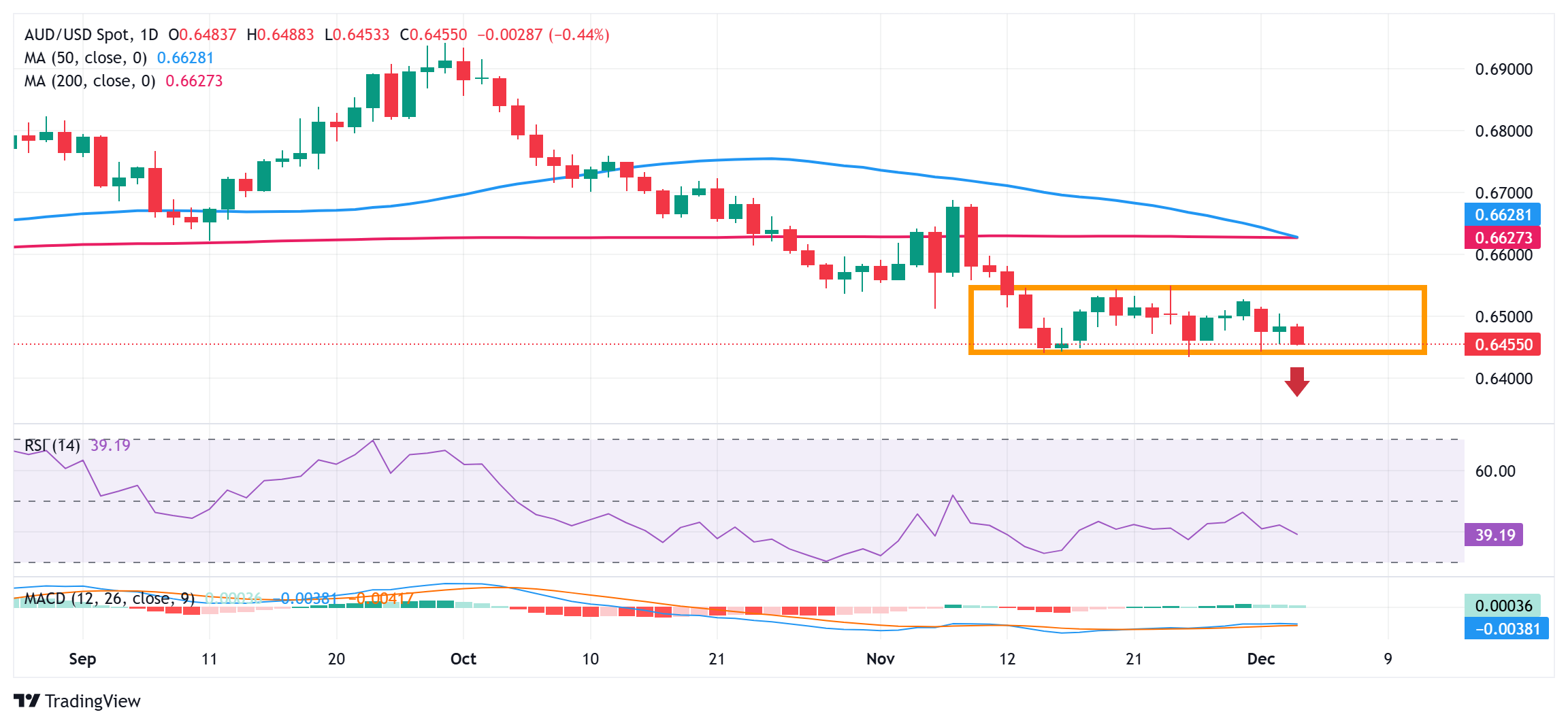- The Australian Dollar attracts some sellers following the release of weaker domestic GDP.
- China’s economic woes and fears of a US-China trade war also undermine the AUD, China’s proxy.
- USD bulls remain on the sidelines ahead of Powell’s speech, lending support to AUD/USD.
The Australian Dollar (AUD) moves lower in reaction to weaker domestic Gross Domestic Product (GDP) growth figures. With headline inflation in Australia having fallen to the central bank’s target range of 2%-3%, slower growth could pressure the Reserve Bank of Australia (RBA) to respond with lower interest rates. Furthermore, new US export restrictions on China, concerns over China’s fragile economic recovery and US President-elect Donald Trump’s impending tariffs turn out to be another factor weighing on the AUD, China proxy.
The US Dollar (USD), on the other hand, remains supported by expectations of a less dovish Federal Reserve (Fed), although bulls choose to wait for more clues on the future path of rate cuts. This, in turn, helps the AUD/USD pair stay above the weekly low and a multi-month low touched last Tuesday. Traders could also choose to wait for Fed Chair Jerome Powell’s speech later today. In addition to this, the US Non-Farm Payrolls (NFP) report should influence the US interest rate outlook and provide fresh directional impetus.
Australian Dollar Moves Lower as Weak GDP Raises Chances of Early RBA Rate Cut
- The Australian Bureau of Statistics (ABS) reported on Wednesday that the economy expanded by 0.3% in the third quarter and 0.8% in annual terms, missing estimates of a reading of 0.4% and 1.1%, respectively.
- Commenting on the critical economic report, Australian Treasurer Jim Chalmers said the national accounts show positive but weak GDP growth and it is encouraging to see growth in real disposable income.
- According to the latest data released by Caixin on Wednesday, China’s Services Purchasing Managers’ Index (PMI) decreased to 51.5 in November from 52.0 in October.
- The US announced a new set of export controls to curb China’s technological advances and restricted the sale of equipment crucial to the manufacturing of semiconductors and high-capacity computer memory to the country.
- This comes after US President-elect Donald Trump threatened a 100% tariff on the BRICS nations – Brazil, Russia, India, China and South Africa – if they undermine the US dollar by creating or supporting alternative currencies. .
- Data from the US Job Openings and Labor Turnover Survey (JOLTS) released on Tuesday showed that the number of job openings on the last business day of October was 7.74 million, up from 7.37 million for the month former.
- The data eases fears of a significant slowdown in the US labor market and could force the Federal Reserve to take a cautious stance on rate cuts amid expectations that Trump’s accommodative policies will boost inflation. .
- US Treasury yields soared in reaction to the upbeat data, although they failed to impress US Dollar bulls as markets still price in a higher likelihood of the Fed cutting borrowing costs again in December.
- San Francisco Fed President Mary Daly said the US economy is in a very good place, while the labor market is in balance and is not a source of inflation. Daly added that a rate cut in December is not out of the question.
- Board of Governors member Adrianna Kugler reiterated that progress on inflation is still underway, while policy is not on a preset course and that the central bank will make decisions meeting by meeting.
- On top of this, Chicago Fed President Austan Goolsbee said rates remain on a tight policy and need to come down a considerable amount from where they are now over the next year if inflation is anywhere near target.
- Market attention is now focused on Fed Chair Jerome Powell’s speech, which, along with Friday’s US Nonfarm Payrolls (NFP) report, should guide monetary policymakers on its next monetary policy decision.
AUD/USD Bears Await a Break Below Short-Term Trading Range Support Near 0.6440-0.6435
From a technical perspective, the range-bound price action over the past two weeks or so could still be classified as a bearish consolidation phase in the context of the decline from September’s monthly high. Furthermore, the oscillators on the daily chart remain in negative territory and are still far from being in the oversold zone. This, in turn, suggests that the path of least resistance for the AUD/USD pair is to the downside and supports the prospects of a further depreciation move. That said, it will still be prudent to wait for some follow-through selling below the 0.6440-0.6435 region, or multi-month low, before opening new positions. Spot prices could then become vulnerable to weakening further below the 0.6400 mark and retesting the year-to-date low, around the 0.6350-0.6345 region touched in August.
On the other hand, any significant recovery above the psychological mark of 0.6500 will likely face strong resistance and remain capped near the supply zone of 0.6535-0.6540. Sustained strength beyond, however, could trigger a short-covering rally and allow the AUD/USD pair to reclaim the 0.6600 round figure en route to the 0.6625-0.6630 confluence hurdle. The latter comprises the 200-day and 50-day simple moving averages (SMA), which if breached decisively could shift the short-term bias in favor of bullish traders and pave the way for additional gains.
economic indicator
Gross Domestic Product (YoY)
The GDP is published by Australian Bureau of Statistics and is an estimate of the total value of goods, services and structures produced in Australia. It is a gross measure of economic activity because it indicates the rate of growth of a country’s economy. A reading above expectations is bullish for the Australian dollar, while a reading below is bearish.
Last post:
Wed Dec 04, 2024 00:30
Frequency:
Quarterly
Current:
0.8%
Dear:
1.1%
Previous:
1%
Fountain:
Australian Bureau of Statistics
The Australian Bureau of Statistics (ABS) publishes the Gross Domestic Product (GDP) quarterly. It is published about 65 days after the end of the quarter. The indicator is closely watched as it presents an important picture for the economy. A strong labor market, rising wages and rising private capital spending data are critical to the country’s improved economic performance, which in turn affects the Reserve Bank of Australia’s (RBA) monetary policy decision and the Australian dollar. . Actual numbers beating estimates are considered bullish for the AUD as they could prompt the RBA to tighten its monetary policy.
Source: Fx Street
I am Joshua Winder, a senior-level journalist and editor at World Stock Market. I specialize in covering news related to the stock market and economic trends. With more than 8 years of experience in this field, I have become an expert in financial reporting.








